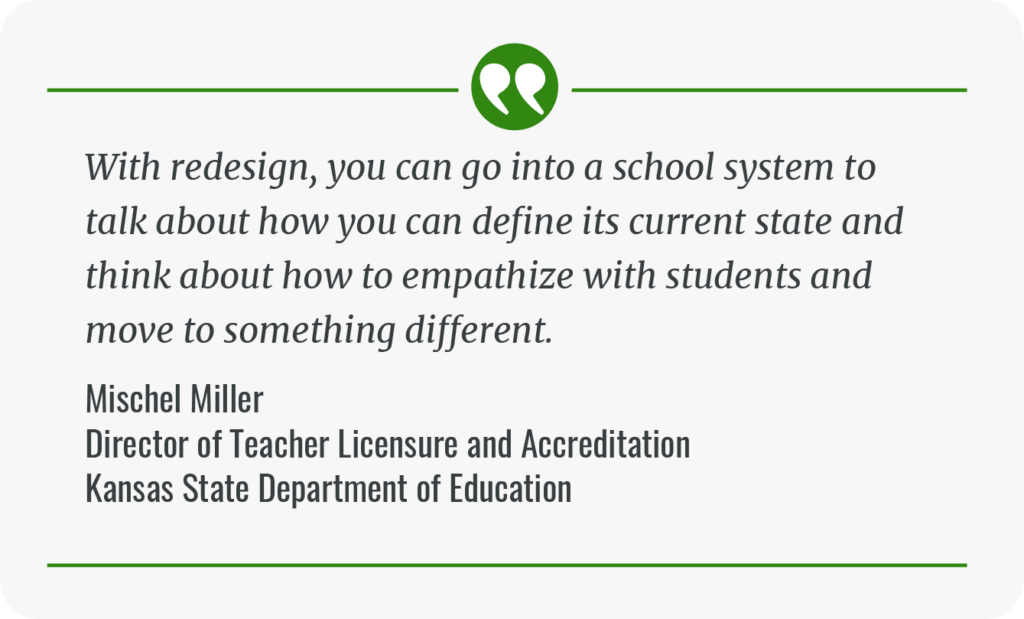Voices from the Field spotlights stakeholders in Region 12 and their work to improve educational opportunities and outcomes. R12CC is privileged to collaborate with and share the insights of Mischel Miller, Director of Teacher Licensure and Accreditation at the Kansas State Department of Education.

What is the goal of Kansans Can Redesign?
The overall mission of the State Board of Education is to lead the world in the success of each and every student. That vision and mission is clear in Kansas and I believe it is clear to all educators more now than it ever has been in my almost 35 years of being involved in Kansas education.
Every system must go through an accreditation process, as they all are working toward being accredited by the State Board. Our accountability measures were too narrow under the old accreditation model. With the new model of redesign, I can engage schools in continuous improvement and that helps support every student being successful using design principles that engage students in more personalized, project-based, real world experiential activities.
What is your role related to Kansans Can Redesign?
Accreditation, the continuous improvement model for KSDE, was given a great deal of emphasis and connected to the redesign project. About 18 months ago, I started to work with three western Kansas school systems in their redesign process. I went out there monthly with the KSDE team and a member of the local education service center in western Kansas. We worked with these districts’ elementary, middle, and high schools to bring them through the redesign process and help them problem solve where they were, where they wanted to be, and how they could move from point A to point B. These districts have a great group of leaders and are in a phenomenal position for continuous growth.
We worked with the schools on the ground level that first year and were working with them last year when the pandemic hit. Everything that would have launched and moved them forward sort of hit a stopping point. However, I believe that their deep engagement in the redesign process may have helped these school systems to maneuver the pandemic challenges with a bit more grace.
Can you describe what the redesign process entails?
We use design thinking, which starts with empathizing. The very first project we do with redesign school systems is to get every participant to think about one particular child who might not be as engaged in education as we would like for them to be, and to relate and empathize with that child or that student’s current educational state. Then we ask them to think about what a day for that child could look like that would be more energizing, more engaging, and more involved. We let groups of educators really think about that particular student and then take all current perceived restraints away and imagine something brand new for that student. Participants then draw a picture of a day that is engaging—a day that would really put a child at the center of learning and ownership of the process.
This is just one of the intentional processes of redesign that I have really come to appreciate relative to the work of accreditation. Sometimes folks see accreditation as a rule-following process—a checklist of responsibilities simply used to fulfill compliance concerns. Whereas with redesign, you can go into a school system to talk about how you can define its current state and think about how to empathize with students and move to something different. It has been my responsibility to marry accreditation into this redesign process. To take a very structured process, let people imagine, let people engage in something new and say, by the way friends, the gift in the end is accreditation. When school systems get there, then we will change the face of education in Kansas.
What does success look like?
From the students’ standpoint, it is each student being able to engage in a meaningful, rigorous learning process that leads them to a successful outcome after high school graduation. It isn’t always going to be a four-year college, it could be a two-year, could be a one-year certificate, it could be home to the run the family business in a more successful manner. Redesign should create an engaging, meaningful process that helps students determine that next level of success for their personal goals in life.
It’s really hard to measure a feeling, but you feel it when you walk into a building that’s taken this journey. You feel a sense of engagement, a sense of belonging, a sense of success for each student. Something like you have never felt before. That, to me, is success at the at the building level and what is best for Kansas kids.
